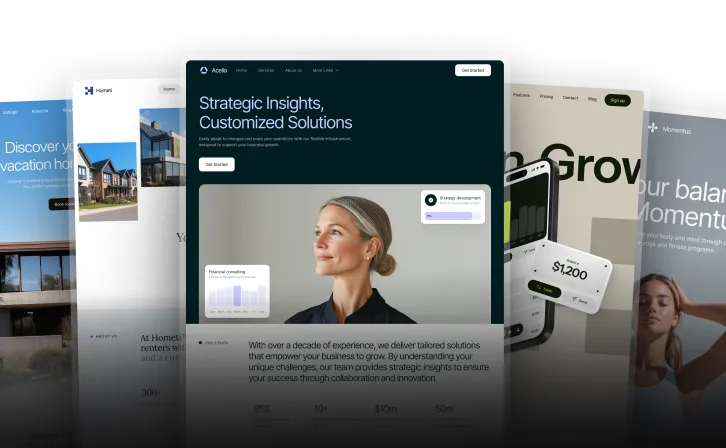Webflow vs Squarespace: Which Website Builder is Right for You
Unlock all templates




Choosing between Webflow and Squarespace? Here's the quick answer:
- Webflow is for users who want full design control, advanced customization, and are comfortable with a steeper learning curve. It's ideal for designers, developers, and businesses needing scalable, dynamic websites.
- Squarespace is for beginners or small businesses who want an easy-to-use platform with pre-designed templates and quick setup. It's perfect for portfolios, blogs, and simple online stores.
Quick Comparison
| Feature | Webflow | Squarespace |
|---|---|---|
| Design Freedom | Unlimited customization, no templates | Pre-designed templates, limited tweaks |
| Ease of Use | Steep learning curve | Beginner-friendly, drag-and-drop |
| E-commerce | Advanced tools, full control | Built-in, simple setup |
| Pricing | Starts at $14/month | Starts at $16/month |
| Code Access | Full HTML/CSS/JS support | Limited customization |
| Support | Tutorials, guides | 24/7 customer support |
Bottom line: Choose Webflow for flexibility and growth potential. Opt for Squarespace if you need simplicity and speed.
Webflow vs Squarespace Review: Pros, Cons, and Full Comparison

Platform Usability
When comparing Webflow and Squarespace, it's clear they approach website creation and management in very different ways. A 2024 study sheds light on their usability differences.
Here’s a closer look at how each platform handles usability.
Webflow: Designed for Advanced Users
Webflow's interface is similar to professional design tools like Adobe Illustrator. While this setup is ideal for experienced designers, it can be overwhelming for beginners. The platform scores 3/5 for ease of use, largely due to its complexity. Some of its standout tools include:
- Advanced layout customization
- Detailed controls for individual elements
- Interactive design options
- Custom animation settings
Although these tools offer immense creative freedom, they require a significant time investment to master.
Squarespace: Beginner-Friendly and Streamlined
Squarespace, on the other hand, is known for its user-friendly interface, earning a 4.4/5 rating for ease of use. Its smart grid system aligns elements automatically, making the design process much simpler. Key features include:
- A visual drag-and-drop editor
- Pre-designed section layouts
- Easy-to-manage content tools
- Built-in responsive design functionality
This platform is particularly appealing to users who want to build a professional website quickly without much technical know-how.
Usability Comparison Chart
| Feature | Webflow | Squarespace |
|---|---|---|
| Learning Time | 2–4 weeks for proficiency | 1–2 days for basics |
| Interface Type | Professional design tool | Simple drag-and-drop |
| Design Freedom | Full creative control | Template-based with limits |
| Technical Knowledge | HTML/CSS understanding helpful | No technical skills needed |
| Support Resources | Extensive tutorials and guides | 24/7 support and resources |
| Editor Experience | Complex menus, technical terms | Clean, section-based layout |
Both platforms aim to simplify website creation but cater to different types of users. Webflow is best suited for those willing to invest time in mastering its tools to achieve complete creative control. Meanwhile, Squarespace is perfect for beginners who need a quick, professional-looking website without diving into technical details.
These differences in usability lay the groundwork for exploring each platform's design flexibility.
Design Options and Control
Webflow and Squarespace take different paths when it comes to design, reflecting unique philosophies and approaches.
Webflow: Advanced Design Tools
Webflow provides a suite of professional-grade tools that rival the flexibility of custom coding. Its visual interface gives designers the freedom to create one-of-a-kind experiences without writing code.
Here’s what Webflow brings to the table:
- Interactions 2.0: Build complex scroll effects, hover animations, and dynamic transitions with ease.
- Custom Animation Control: Create intricate animations without needing coding expertise.
- Full HTML/CSS Access: Dive into every design detail directly using the visual editor.
- CMS Integration: Manage scalable content while keeping the design intact.
- Built-in SEO Tools: Fine-tune schema markup and optimize page load speeds.
Squarespace: Template Options
Squarespace focuses on pre-designed templates, offering a more structured and user-friendly approach. It prioritizes simplicity over flexibility, making it a great choice for users who want stylish results quickly.
Squarespace’s design system includes:
- Responsive Templates and Sections: Pre-built layouts with modular content blocks that adapt seamlessly across devices.
- Style Editor: Adjust basic elements like colors, fonts, and spacing.
- Limited Code Integration: Minimal access to HTML/CSS for advanced customization.
- Grid-Based Layouts: A structured system for consistent and clean alignment.
Design Features Chart
| Feature | Webflow | Squarespace |
|---|---|---|
| Design Freedom | Unlimited customization | Template-based options |
| Starting Point | Blank canvas or template | Pre-designed templates |
| Animation Capabilities | Advanced custom effects | Basic hover animations |
| Code Access | Full HTML, CSS, JS | Limited custom code |
| Template Customization | Fully editable | Surface-level changes |
| Design Learning Curve | Steep but rewarding | Easy but restrictive |
| Responsive Design | Manual control/testing | Automatic adaptation |
| Custom Interactions | Multi-step animations | Simple transitions |
Squarespace simplifies the design process with polished templates and quick setup, while Webflow offers unparalleled creative control for those willing to invest the time to master its tools. These differences highlight how each platform caters to different user needs, setting the stage for a broader comparison in the sections ahead.
sbb-itb-fdf3c56
Online Store Features
Webflow and Squarespace take different paths when it comes to creating and managing online stores.
Webflow: E-commerce Tools
Webflow gives you the ability to fully customize your online store using a visual editor. This platform is ideal for those who want control over every aspect of their store's design and functionality. Here’s what it offers:
- Custom Checkout Flow: Design and style your checkout process exactly how you want.
- Payment Integration: Supports major payment processors like Stripe and PayPal.
- Shipping Management: Works with Shippo to set shipping rates based on order cost, weight, quantity, or price.
- Email Customization: Add your branding to transactional emails for a polished customer experience.
- Dynamic Product Filtering: Let customers navigate your store with advanced filtering options.
Pricing starts at $29 per month (billed annually) on the Standard plan, which includes a 2% transaction fee. The Plus plan costs $74 per month and removes transaction fees, while the Advanced plan is priced at $212 per month and caters to larger stores with additional needs.
Squarespace, by contrast, focuses on simplicity with built-in tools for quick and easy store setup.
Squarespace: Built-in Store Features
Squarespace provides an all-in-one solution that’s easy to use but still packed with the essentials. Its features include:
- Integrated Payment Systems: Works with Squarespace Payments, Stripe, PayPal, and Square.
- Simplified Shipping: Offers flat-rate and weight-based shipping, plus carrier-calculated rates for U.S. users on higher-tier plans.
- Product Management: Manage inventory and product variants with ease.
- Print-on-Demand: Seamless integration with Printful for custom merchandise.
- Service Sales: Tools for selling services, courses, and managing bookings.
The Commerce Basic plan starts at $28 per month (billed annually) with no transaction fees. For $52 per month, the Commerce Advanced plan adds extra tools for growing businesses.
E-commerce Features Comparison
Here’s a side-by-side look at what each platform offers:
| Feature | Webflow | Squarespace |
|---|---|---|
| Starting Price | $29 per month | $28 per month |
| Transaction Fees | 2% (Standard plan) | None |
| Payment Gateways | Stripe, PayPal | Stripe, PayPal, Square |
| Design Control | Full customization | Template-based |
| Shipping Options | Four methods | Three methods |
| Product Types | Physical and digital | Physical, digital, services |
| Inventory Management | Advanced | Basic |
| Email Customization | Extensive control | Template-based |
These differences highlight how each platform caters to specific needs. For instance, Midwest Mutt Shop, built with Webflow, showcases creative layouts and animations, while Roar Pet Food uses Squarespace for a clean, simple design that prioritizes ease of use.
Cost Analysis
Webflow: Pricing Breakdown
Webflow has separate pricing for websites, e-commerce stores, and team workspaces:
- Standard Websites (annual billing): Basic at $14/month, CMS at $23/month, and Business at $39/month.
- E-commerce Plans: Standard at $29/month (2% transaction fee), Plus at $74/month (no transaction fee), and Advanced at $212/month (no transaction fee).
- Workspace Plans: Core at $19/month, Growth at $49/month, and Enterprise with custom pricing.
Squarespace: Pricing Overview
Squarespace offers bundled packages that include hosting, security, and essential features. The Business plan has a 3% transaction fee, while Commerce plans remove this fee.
Additional costs include domain renewals ($20–$70/year), Google Workspace (around $6/month), and payment processing fees (approximately 2.9% + $0.30 per transaction).
Here’s a quick comparison of the two platforms:
| Feature | Webflow | Squarespace |
|---|---|---|
| Entry-level Site Plan | $14/month (Basic) | Pricing available on request |
| E-commerce Starting Price | $29/month (Standard plan) | Pricing available on request |
| Transaction Fees | 2% on Standard; 0% on higher tiers | 3% on Business; 0% on Commerce |
| CMS Items | Basic: None; CMS: 2,000; Business: Unlimited | Unlimited across plans |
| Workspace Options | Available from $19/month | Limited team features |
Webflow is ideal if you need detailed customization, while Squarespace shines with its simple, all-in-one approach.
Conclusion
Here's a quick recap to help you decide between Webflow and Squarespace based on your needs.
When to Choose Webflow
Webflow is a great fit for design agencies, marketing teams, and businesses aiming to grow their online presence. Its powerful CMS can handle complex content and dynamic websites, making it ideal for teams that need advanced features and flexibility.
When to Choose Squarespace
Squarespace shines with its user-friendly interface and wide range of templates. It's perfect for small businesses, creative professionals, and content creators who want an easy-to-use platform. It works especially well for:
- Creative portfolios
- Small business websites
- Content creators
- Service-based businesses
Key Factors to Consider
Here's a side-by-side comparison to simplify your decision:
| Choose Webflow If You Need | Choose Squarespace If You Need |
|---|---|
| Full design flexibility | Easy setup and maintenance |
| Access to technical expertise | Drag-and-drop simplicity |
| Room for significant growth | Basic e-commerce functionality |
| Advanced CMS options | All-in-one pricing |
| Custom animations and effects | Pre-designed templates |
For small businesses and individuals, Squarespace offers a straightforward solution with pricing plans between $16 and $52 per month. On the other hand, Webflow is better suited for complex, dynamic websites - especially if you have the technical skills or team to make the most of its customization options. Its Site and Workspace plans may cost more, but the added flexibility and scalability could be worth it.
Your choice ultimately depends on whether you prioritize creative freedom or ease of use.
Related Blog Posts
Recommended posts
Unlock all templates







